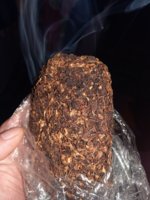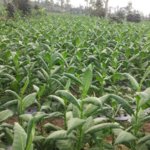Tutu
Well-Known Member
I think that if Indonesians were able to see your methods they would be proud that their ways with tobacco made it as far as Canada.
Let me get back at that article, which Charly posted. It's a nice find and I haven't read it before. It's quite rare to find articles about Indonesian tobacco written in English. For those that want to learn from it, I'll have to correct them on a few minor issues.
The first thing I want to go into is their mentioning of the seasons. They are missing a season. They mention two, but there are three. They got Voor Oogst, which indeed begins at the start of the wet season and ends in the dry season. This season is mostly important for cigarette and kretek cigarette tobacco. They got Na Oogst right, also called Nota (Na Oogst Tanaman Awal), which runs through the dry season and traditionally ends before the wet season begins. Then the one they are missing out on is tha Utara, which literally means North, but it's also called Na Oogst (by farmers who refer to the earlier season only as Nota). This season begins in the dry season but runs into the wet season. Then you may have people referring to a Semi-Nota, which is inbetween the Nota and the Utara.
Now they fail to explain that to a large extend the sun cured and the sliced, the Rajangan, comes from the same plant. When mentioning sun cured they refer to Kasturi. Kasturi is completely its own thing. But the sliced tobaccos they mention prior to that, like the Madura and Paiton, but many others like Maesan, Bojonegoro, is also used for sun-cured. You'll have sun cured coming from the lower and top plant positions, while there's the slicing for the middle plant positions. I think this is an important point to make. It's not as if there are are always separate Rajangan fields, or varieties, and sun cured varieties. The two intertwine. Except for Kasturi though.
I have never heard of Indonesian tobacco being sold at market price for IDR 500.000 per kilogram. I'm a buyer myself, and we'd go broke if we'd pay that. I've never bought the Srinthil, but plainly I don't believe the article on this one. I know it says it's limited supply, but half of Indonesia would start growing the stuff if they heard about this.
I've often had Madura samples tested for nicotine and they usually have a hard time reaching 2%. So the 3-5% mentioned is exaggerated.
I know where the pictures in the article are from. They're from a website offering seed. I've ordered seed from the website, paid for it, but they failed to deliver.
Kasturi planting is said to be from May until June. Now it may have been traditionally because the Voor Oogst season runs around that time, but the season runs until September to October these days. There's a field not far from my house which still has a farmer harvesting his sucker crop. It's November-time already. Then, the article mention that ISFCRI has legalized two new strains of Kasturi. But it's important to keep in mind that farmers really don't give a rat's ass about these things. They'll just plant their own retained varieties. So generally, those two varieties are not the ones grown. I know what they look like and you hardly ever see them.
I do think they are spot on on their flue cured numbers. That has to be said.
Bob was right, they misspelled "cigar" as "cigarette" at the end of the article. Bad slip-up I'd say. They are completely right by saying that the yield in the South of Jember is higher than it is in the North. I believe it's for the wrong reason. It may be rainfall, but that's only because of the difference in season. More importantly, I think it's the varieties they plant.
They miss-spell Omblad and Dekblad, using one to many "a's" in both. But far worse, they translate them wrong. They say Omblad is Wrapper, whereas Omblad is both Dutch and Indonesian for Binder. Then Dekblad they say is Binder, where it means Wrapper in both Dutch and Indonesian. This one hurts, I have to say...
Let me get back at that article, which Charly posted. It's a nice find and I haven't read it before. It's quite rare to find articles about Indonesian tobacco written in English. For those that want to learn from it, I'll have to correct them on a few minor issues.
The first thing I want to go into is their mentioning of the seasons. They are missing a season. They mention two, but there are three. They got Voor Oogst, which indeed begins at the start of the wet season and ends in the dry season. This season is mostly important for cigarette and kretek cigarette tobacco. They got Na Oogst right, also called Nota (Na Oogst Tanaman Awal), which runs through the dry season and traditionally ends before the wet season begins. Then the one they are missing out on is tha Utara, which literally means North, but it's also called Na Oogst (by farmers who refer to the earlier season only as Nota). This season begins in the dry season but runs into the wet season. Then you may have people referring to a Semi-Nota, which is inbetween the Nota and the Utara.
Now they fail to explain that to a large extend the sun cured and the sliced, the Rajangan, comes from the same plant. When mentioning sun cured they refer to Kasturi. Kasturi is completely its own thing. But the sliced tobaccos they mention prior to that, like the Madura and Paiton, but many others like Maesan, Bojonegoro, is also used for sun-cured. You'll have sun cured coming from the lower and top plant positions, while there's the slicing for the middle plant positions. I think this is an important point to make. It's not as if there are are always separate Rajangan fields, or varieties, and sun cured varieties. The two intertwine. Except for Kasturi though.
I have never heard of Indonesian tobacco being sold at market price for IDR 500.000 per kilogram. I'm a buyer myself, and we'd go broke if we'd pay that. I've never bought the Srinthil, but plainly I don't believe the article on this one. I know it says it's limited supply, but half of Indonesia would start growing the stuff if they heard about this.
I've often had Madura samples tested for nicotine and they usually have a hard time reaching 2%. So the 3-5% mentioned is exaggerated.
I know where the pictures in the article are from. They're from a website offering seed. I've ordered seed from the website, paid for it, but they failed to deliver.
Kasturi planting is said to be from May until June. Now it may have been traditionally because the Voor Oogst season runs around that time, but the season runs until September to October these days. There's a field not far from my house which still has a farmer harvesting his sucker crop. It's November-time already. Then, the article mention that ISFCRI has legalized two new strains of Kasturi. But it's important to keep in mind that farmers really don't give a rat's ass about these things. They'll just plant their own retained varieties. So generally, those two varieties are not the ones grown. I know what they look like and you hardly ever see them.
I do think they are spot on on their flue cured numbers. That has to be said.
Bob was right, they misspelled "cigar" as "cigarette" at the end of the article. Bad slip-up I'd say. They are completely right by saying that the yield in the South of Jember is higher than it is in the North. I believe it's for the wrong reason. It may be rainfall, but that's only because of the difference in season. More importantly, I think it's the varieties they plant.
They miss-spell Omblad and Dekblad, using one to many "a's" in both. But far worse, they translate them wrong. They say Omblad is Wrapper, whereas Omblad is both Dutch and Indonesian for Binder. Then Dekblad they say is Binder, where it means Wrapper in both Dutch and Indonesian. This one hurts, I have to say...





